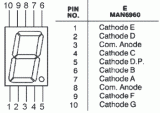Small, portable, anti-bag-snatching unit
Also suitable for doors and windows control
Parts:
R1 330K 1/4W Resistor
R2 100R 1/4W Resistor
C1 10nF 63V Polyester or Ceramic Capacitor
C2 100µF 25V Electrolytic Capacitor
Q1 BC547 45V 100mA NPN Transistor
Q2 BC327 45V 800mA PNP Transistor
SW1 Reed Switch and small magnet (See Notes)
SPKR 8 Ohm Loudspeaker (See Notes)
B1 3V Battery (two A or AA cells wired in series etc.)
Device purpose:
This circuit, enclosed in a small plastic box, can be placed into a bag or handbag. A small magnet is placed close to the reed switch and connected to the hand or the clothes of the person carrying the bag by means of a tiny cord.
If the bag is snatched abruptly, the magnet looses its contact with the reed switch, SW1 opens, the circuit starts oscillating and the loudspeaker emits a loud alarm sound.
The device can be reverse connected, i.e. the box can be placed in a pocket and the cord connected to the bag.
This device can be very useful in signalling the opening of a door or window: place the box on the frame and the magnet on the movable part in a way that magnet and reed switch are very close when the door or window is closed.
Circuit operation:
A complementary transistor-pair is wired as a high efficiency oscillator, directly driving a small loudspeaker. Low part-count and 3V battery supply enable a very compact construction.
Notes:
The loudspeaker can be any type, its dimensions are limited only by the box that will contain it.
An on-off switch is unnecessary because the stand-by current drawing is less than 20µA.
Current consumption when the alarm is sounding is about 100mA.
If the circuit is used as anti-bag-snatching, SW1 can be replaced by a 3.5mm mono Jack socket and the magnet by a 3.5mm. mono Jack plug with its internal leads shorted. The Jack plug will be connected with the tiny cord etc.
Do not supply this circuit with voltages exceeding 4.5V: it will not work and Q2 could be damaged. In any case a 3V supply is the best compromise.
Author: RED Free Circuit Designs
Email:
Website: http://www.redcircuits.com

 Audio
Audio







